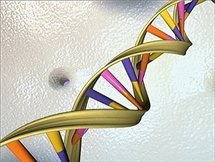
The DNA double helix (AFP/HO/File)
They are also "dramatic," which makes it easier for scientists to detect them using the new method, which has been dubbed PARE, for Personalized Analysis of Rearranged Ends, said Victor Velculescu, an associate professor of oncology at Johns Hopkins and senior author of the study.
"If the genome were like a book with many chapters, the rearrangement would be like swapping two chapters in a book so they would be out of order," he said.
"In contrast, a single base mutation is like a single typo within a chapter," he said.
Up to now, researchers have focused on those single-letter changes when sequencing individuals' genomes.
But PARE looks at the whole genome -- the chapter of the book as opposed to the single typo.
"It's easier to see if chapters are out of order when flipping through a book than to spot a typo.
"So if we could reconize the DNA rearrangement accurately, that would be one of the best ways to distinguish cancer cells from normal cells," Velculescu told reporters at the annual conference of the American Association for the Advancement of Science (AAAS), where PARE was unveiled.
"PARE is exquisitely sensitive to tumor DNA and will be useful to detect hidden or clinically undetected tumors that are not apparent on CT scans," said Luis Diaz, another Johns Hopkins oncology professor who co-authored the study.
PARE could also be used to determine if a patient's cancer was completely removed by surgery, which would help to avoid unnecessarily giving chemotherapy and radiation treatment post-operatively to cancer patients.
The researchers hope PARE's cancer detection methods will be accessible to clinicians and their patients within the next two years, said Diaz.
He and Velculescu cautioned that PARE is not the silver bullet that will end cancer, but said their method was the first clinically useful application of whole genome sequencing.
For the study, the researchers analyzed four tumor samples -- two colon and two breast tumors -- and compared them with normal tissue sample, in which there has been no rearranging of DNA.
They identified DNA rearrangements in the tumor samples, and also found the same changes in DNA shed from tumors into the blood.
A stumbling block to widespread use of PARE currently is its price tag: a genome scan today costs around 5,000 dollars per patient, Velculescu said.
CT scans cost around 1,500 dollars per scan, but are limited in their ability to detect tiny cancers.
PARE is expected to rapidly become more cost-effective than CT scans, and "could prove to be more informative," said oncologist Kenneth Kinzler.
"As PARE becomes affordable, it will be a helpful addition for physicians to tailor patient care and may become a useful supplement to traditional monitoring by imaging or other approaches," said Rebecca Leary, a graduate student at the Johns Hopkins Kimmel Cancer Center, who also worked on the study.
The study will be published next week in Science Translational Medicine.
---------------------------------------------------------------------
"If the genome were like a book with many chapters, the rearrangement would be like swapping two chapters in a book so they would be out of order," he said.
"In contrast, a single base mutation is like a single typo within a chapter," he said.
Up to now, researchers have focused on those single-letter changes when sequencing individuals' genomes.
But PARE looks at the whole genome -- the chapter of the book as opposed to the single typo.
"It's easier to see if chapters are out of order when flipping through a book than to spot a typo.
"So if we could reconize the DNA rearrangement accurately, that would be one of the best ways to distinguish cancer cells from normal cells," Velculescu told reporters at the annual conference of the American Association for the Advancement of Science (AAAS), where PARE was unveiled.
"PARE is exquisitely sensitive to tumor DNA and will be useful to detect hidden or clinically undetected tumors that are not apparent on CT scans," said Luis Diaz, another Johns Hopkins oncology professor who co-authored the study.
PARE could also be used to determine if a patient's cancer was completely removed by surgery, which would help to avoid unnecessarily giving chemotherapy and radiation treatment post-operatively to cancer patients.
The researchers hope PARE's cancer detection methods will be accessible to clinicians and their patients within the next two years, said Diaz.
He and Velculescu cautioned that PARE is not the silver bullet that will end cancer, but said their method was the first clinically useful application of whole genome sequencing.
For the study, the researchers analyzed four tumor samples -- two colon and two breast tumors -- and compared them with normal tissue sample, in which there has been no rearranging of DNA.
They identified DNA rearrangements in the tumor samples, and also found the same changes in DNA shed from tumors into the blood.
A stumbling block to widespread use of PARE currently is its price tag: a genome scan today costs around 5,000 dollars per patient, Velculescu said.
CT scans cost around 1,500 dollars per scan, but are limited in their ability to detect tiny cancers.
PARE is expected to rapidly become more cost-effective than CT scans, and "could prove to be more informative," said oncologist Kenneth Kinzler.
"As PARE becomes affordable, it will be a helpful addition for physicians to tailor patient care and may become a useful supplement to traditional monitoring by imaging or other approaches," said Rebecca Leary, a graduate student at the Johns Hopkins Kimmel Cancer Center, who also worked on the study.
The study will be published next week in Science Translational Medicine.
---------------------------------------------------------------------









 Home
Home Politics
Politics









